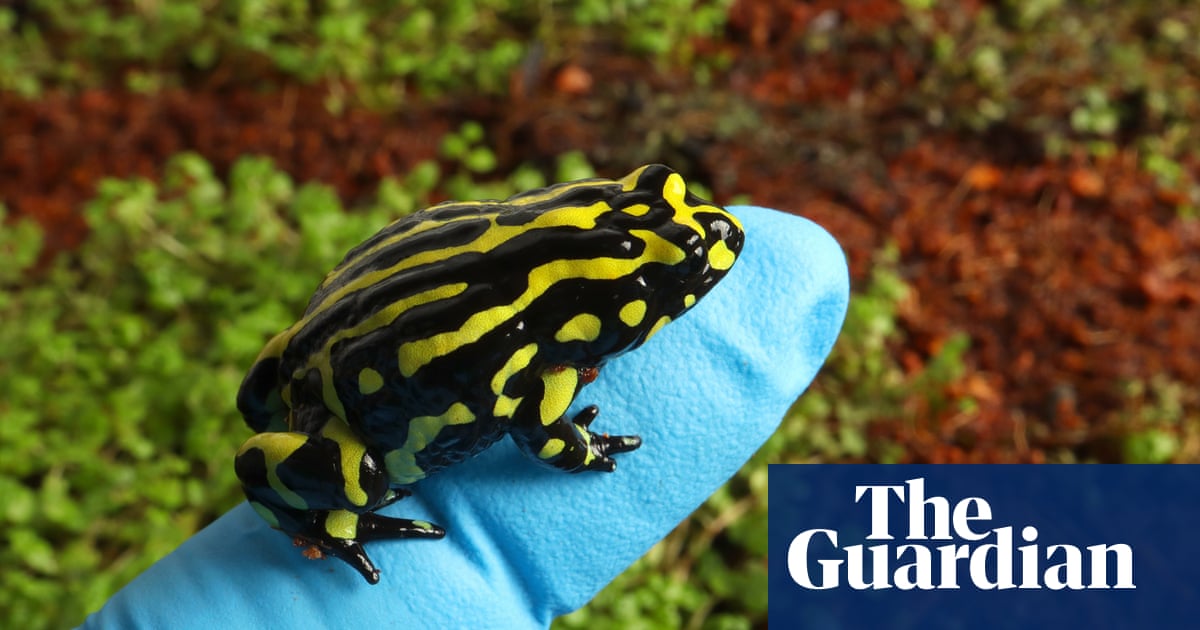Scientists have sequenced the genome of the critically endangered southern corroboree frog – one of Australia’s most threatened amphibians – in hope that the information could be used to aid its recovery.
The striking alpine frog, which has distinctive yellow and black markings, is so threatened by disease and the drying of its habitat due to climate change, that it is considered “functionally extinct”. The species survives in the temporary pools and peat bogs of Kosciuszko national park inNew South Wales, with the help of zoo breeding and re-introduction programs.
“They’re quite unique frogs. They belong to this ancient family of frogs that’s only found in Australia,” said conservation biologist Dr Tiffany Kosch from the University of Melbourne and lead author ofthe paper published in Wellcome Open Research.
“They’re about 100m years old.”
The frog’s genome was equally remarkable. Despite their tiny size, the researchers found their genome was enormous – three times the size of a human’s – and one of the largest for a frog.
“A lot of other frogs in their family have much smaller genomes – including one of the smallest frog genomes on record,” Kosch said, suggesting it indicated something unusual in their evolutionary history.
Their genome was also “full of non-coding DNA” – genetic material that doesn’t directly code for proteins – and repeated elements, she said. “We’re still exploring what this might mean for the species, and for other amphibians.”
Mapping the genome took 10 years of work. Frog tissue collected in Australia had to be transported to New York at temperatures of -80C. Once there, the DNA was extracted and chopped up into “tiny puzzle pieces”, Kosch said, which were analysed and re-assembled by co-authors at the Vertebrate Genome Laboratory.
Kosch has since embarked on new research – made possible by the genome – which aims to explore and understand the species’ susceptibility to the chytrid fungus disease.
“We are trialling methods such as selective breeding and genetic engineering of the frogs to hopefully increase their resistance. So that’s going to be our work for the next five to 10 years,” she said.
“The hope is that work with the southern corroboree frog could be used as a proof-of-concept for other frogs threatened by the chytrid fungus, and potentially other species threatened by climate change. The genome is really just the first step in helping us get there.”
Dr Simon Clulow, an associate professor in conservation ecology at the University of Canberra who was not involved with the research, said having the full genome sequence made it easier to ask and answer questions about a species.
“The main impact on corroboree frogs,as with many frogsaround the world, which are now the most threatened vertebrate class on Earth, is an invasive disease called chytrid fungus,” Clulow said.
One potential avenue for helping the species overcome the disease was identifying resistant genetic traits, he said, and mapping the genome was “a really useful step towards this sort of goal”.
Frog genome research was in its early development, said Prof Nicki Mitchell from the University of Western Australia, a zoologist and Biodiversity Council Member who was not involved with the research.
“For various reasons, frogs have been one of the slowest groups in the vertebrate world to have genomes completed,” she said.
This was partly because frog genomes were relatively larger than other vertebrates and because some species carried “extra genetic baggage”, such as double-copies of chromosomes.
The southern corroboree frog was probably the highest priority for an Australian frog genome, Mitchell said, given it was “our most high profile amphibian on the precipice of extinction”.
While the frog was among 110 priority species identified and supported under the government’s Threatened Species Action Plan, there were about 2,200 listed as threatened under the Environment Protection and Biodiversity Conservation Act.
The funding for biodiversity was “minuscule compared to what we need”, Mitchell said. The Biodiversity Council has called foran increase in nature spending, equivalent to at least 1% of the federal budget.
“The species, in some ways, is a symbol of the twin crises that we’re facing as a globe, of climate change and biodiversity loss.”
